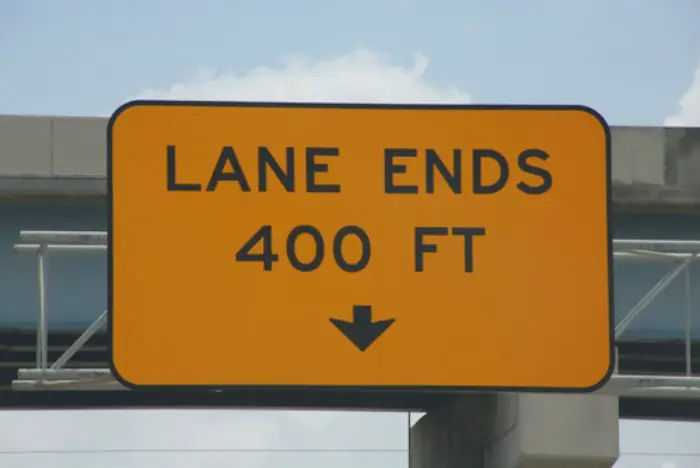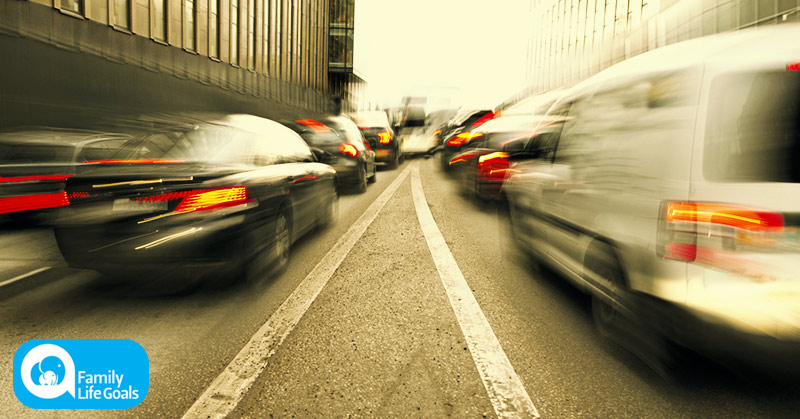It’s rush hour… you’ve just worked an exhausting day, you’re driving into the grueling sun, people are honking like crazy, you’re moving at a snail’s pace, and of course, your lane ends in 1000 feet. The only problem? Even 990 feet later, no one seems to want to let you in and traffic seems to be at a standstill.
Anyone who drives has experienced this problem, whether it’s due to an accident or construction. In a situation such as the one above where you see a “LANE CLOSED IN 1000 FT” sign, there are only two options. You can either (A) immediately flick on your signal and jump into the lane at the first opportunity, or (B) drive another 1000 feet before finally merging into the continuing lane.
What do you do when you’re stuck in traffic? At first glance, the first option seems to be a wiser choice. If you’re sitting there grinding your teeth and clenching your fists at option B, you’re not alone. However, numerous studies have actually shown that people who merge early on create:[1,2]
- A slower, longer, single file line; overall more traffic
- Less usable road (no one wants to be the one who zooms to the end of the empty, ending lane)
- An increase in frustrated drivers
- Higher potential for accidents
Zipper Merge: The Best Way to Prevent Traffic Jams

In Germany, drivers have used the “zipper merge” (or Reißverschlusssystem) for a long time. Even states such as Colorado, Minnesota, Washington, Missouri, and Kansas have made efforts to adopt the zipper merge for over a decade.[3] But, people who have been driving the majority of their lives with that system are reluctant to change. As the saying goes, old habits die hard…
However, what makes zipper merging so effective is that every car on the road uses all available lanes – yes, even the one that is ending. Sounds counterintuitive, right? Yes, but How Stuff Works explains it quite simply:
“Because the system uses all the available road space for as long as possible, it cuts congestion by 40 percent. It also reduces crashes because all the traffic is moving at the same rate of speed rather than some cars going very fast while others poke along.”[3]
When executed effectively, this anti-traffic system begins to take on a pattern that looks zipper-like. This video illustrates how to do the zipper merge in under 90 seconds:
The only problem is that the zipper merge only works when everyone agrees to follow its rules. Obviously, this is basically impossible to do. States that have adopted the zipper merge are training new drivers in this way and are even willing to retrain old drivers, too.
But as long as people keep trying to get where they need to go using whatever system they see fit, traffic jams look like they’re going to be an inevitable part of reality for a long, long time. What you can do, however, is tell all your driving friends and family members about the zipper merge! Hopefully over time, long single-file traffic jams and unnecessary accidents will become a thing of the past!
[1] Dynamic Late Merge Control Concept for Work Zones on Rural Freeways. (n.d.). Retrieved from https://ops.fhwa.dot.gov/wz/workshops/accessible/McCoy.htm
[2] Beacher, A. G., Fontaine, M. D., & Garber, N. J. (2004, August). FINAL REPORT: EVALUATION OF THE LATE MERGE WORK ZONE TRAFFIC CONTROL STRATEGY [PDF]. Charlottesville, Virginia: Virginia Transportation Research Council. https://www.virginiadot.org/vtrc/main/online_reports/pdf/05-r6.pdf
[3] Drivers Who Merge at the Last Minute May Be Annoying … But They’re Right. (2016, November 07). Retrieved from https://auto.howstuffworks.com/traffic-lane-zipper-merge.htm

